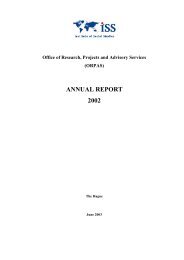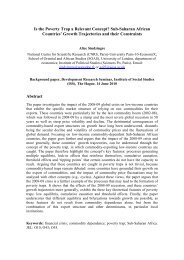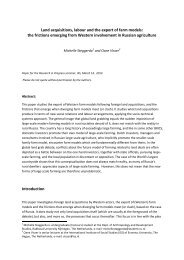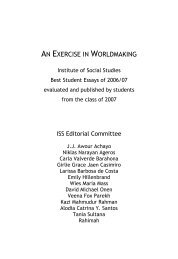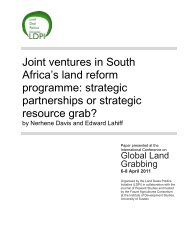AN EXERCISE IN WORLDMAKING 2009 - ISS
AN EXERCISE IN WORLDMAKING 2009 - ISS
AN EXERCISE IN WORLDMAKING 2009 - ISS
You also want an ePaper? Increase the reach of your titles
YUMPU automatically turns print PDFs into web optimized ePapers that Google loves.
17 Intersectionality and Human Rights: Law, Theory and Praxis 205<br />
tion on the Elimination of Discrimination Against Women (CEDAW)<br />
and its treaty body, as well as the actions and programmes that emerge<br />
from CEDAW, cannot fully address gender without understanding how<br />
race, class, sexual orientation, ethnicity, religion, age, disability, culture,<br />
health, citizenship status and other issues intersect with gender. Given<br />
the complexity this implies, how can we avoid making international law<br />
and human rights theory and praxis unworkable? The fuzziness and<br />
amorphous nature of intersectionality is due to the complexity and dynamism<br />
of what it is trying to study (multiple identities and structural<br />
power) as well as its relatively recent emergence in mainstream feminist<br />
and human rights theory.<br />
It is important to understand what we want the concept to do. Intersectionality<br />
cannot solve all the problems that are faced by theorists or<br />
human rights activists and lawyers working at the international level. It<br />
can, however, ask the right questions about power, privilege and access,<br />
as well as uncover the inadequacies and contradictions in current human<br />
rights theory and praxis, as discussed above.<br />
B) Human rights and feminist theories: universalism and<br />
relativism<br />
It is worth asking, and has been asked, how human rights theory as well<br />
as feminist theory can develop coherent and universal theories without<br />
losing the nuances of context. But intersectionality offers a different, and<br />
perhaps contrary, challenge. How do we theorise about multiple identities<br />
and multiple dimensions of oppression without descending into<br />
complete relativism through the claim that “context is everything”? In<br />
other words, while intersectionality offers us the tools or conceptual<br />
framework to understand the complexity of identity, politics, law and<br />
discrimination, it becomes a potential liability if we allow it to deconstruct<br />
us into irrelevance or meaninglessness. After all, how valuable is a<br />
concept if it tells us that one person never experiences oppression like<br />
anyone else due to the nature of multiple and shifting identities over time<br />
and space, and therefore there is no one theory, practice or institution<br />
that will ever have any universal applicability? This conflict between what<br />
Davis calls postmodern theoretical perspectives (which deconstructs binary<br />
labels and abhors any attempts at universalism) and other human<br />
rights theory is potentially resolved by intersectionality (Davis 2008: 8-9),<br />
though perhaps only partially.




